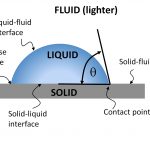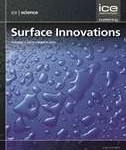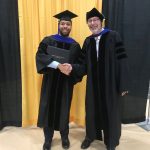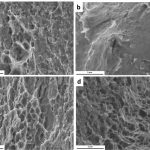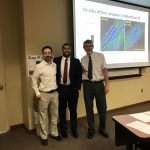We welcome Ms. Isabelle Hemmila, who has joined our research team the Spring semester as an undergraduate researcher. Isabelle is majoring in materials science and engineering program. She has been assigned to assist Dr. Ehsan Mostaed and Ms. Emily Tom in their research on magnesium-based biodegradable alloys. We hope that her research experience will lead her towards her independent project next academic year.
Historical Paper on Contact Angles
An international team of experts in the field of wetting led by Dr. Drelich published a one-of-a-kind contribution on the history of contact angles, their meaning, and use in polymer surface energy estimation. The title of the paper is Contact angles: history of over 200 years of open questions and this paper was published in the first (double) issue of 2020 of Surface Innovations. There has been no similar historical perspective on the origins, evolution, scientific use, and healthy criticisms of the existing interpretations of contact angles offered by any other journal. This historical review will well serve researchers across the disciplines, guiding the readers into the scientific meaning of contact angles and their limitations, and providing directions for new developments in the area of science of contact angles.
SI Volume 8 Issue 1-2
We would like to share with you the content of the first issue of 2020, 8(1-2), of Surface Innovations. This is one of the most impressive issues that we published in seven years. We offer historical review contribution on contact angles, which is available online free-of-charge, and nine quality original papers on a broad variety of topics. Hope many of you will find something interesting among these papers.
Half-Year Commencement
2019 Half-Year Commencement was a celebration of Roger’s graduation with his parents and friends. It was also opportunity to meet Avishan (who defended her MS degree a few years ago) and her husband Rob – awarded with his PhD degree during this ceremony. Congratulations to Roger and Rob and all the students awarded with BS, MS and PhD degrees!
Second Scholar from China
The SURFI Team welcomes a new addition to our team, Zhanglei Zhu. Zhanglei has arrived from the School of Resources and Civil Engineering at Northeastern University in P.R. China in October. He will explore fundamentals of flotation with particles of varying topography and analyzing adhesion between liquid droplets and gas bubbles with solid surfaces of varying surface roughness.
Undergraduate Researcher II
We welcome Ms. Tori Nizzi, who has joined our research team as an undergraduate researcher. Tori is double majoring in mechanical engineering and materials science and engineering programs. She is currently assisting Morteza Ardakani in his research on zinc-based biodegradable alloys but should start her own independent work on computer simulations of biodegradable orthopedic implants in 2020.
Zn-Mg-Cu/Mn Paper
Morteza has published his first first-author paper entitled “The effects of alloying with Cu and Mn and thermal treatments on the mechanical instability of Zn-0.05Mg alloy” in the Materials Science and Engineering A journal. The following is the abstract:
The detrimental effect of natural aging on mechanical properties of zinc alloys restricts their application as bioresorbable medical implants. In this study, aging of Zn-0.05Mg alloy and the effect of 0.5 Cu and 0.1 Mn (in weight percent) addition on the microstructure and tensile properties were studied. The alloys were cold rolled, aged and annealed; aiming to investigate the effects of precipitates and grain size on the mechanical properties and their stability. TEM analysis revealed that in ultrafine-grained binary Zn-0.05Mg alloy, the natural aging occurred due to the formation of nano-sized Mg2Zn11 precipitates. After 90 days of natural aging, the yield strength and ultimate tensile strength of Zn-0.05Mg alloy increased from 197±4 MPa and 227±5 MPa to 233±8 MPa and 305±7 MPa, respectively, while the elongation was drastically reduced from 34±3% to 3±1%. This natural aging was retarded by adding the third element at either 0.1Mn or 0.5Cu quantities, which interacted with Mg in Zn solid solution and impeded the formation of Mg2Zn11 precipitates. The addition of Cu and Mn elements increased alloy’s strength, ductility, and its mechanical stability at a room temperature. The measured tensile strength and elongation were 274±5 MPa and 41±1% for Zn-0.1Mn-0.05Mg and 312±2 MPa and 44±2% for Zn-0.5Cu-0.05Mg, respectively. Annealing the alloys at elevated temperatures caused increase in both grain size and dissolution of secondary phases, and both affected alloy deformation mechanisms.
Undergraduate Researcher
We welcome Ms. Emily Tom, who has joined our research team as an undergraduate researcher. Emily is senior in materials science and engineering program. She will assist our team in research on zinc- and magnesium-based biodegradable alloys.
Dr. Guillory
Congratulations to Roger Guillory for defending his PhD dissertation entitled “Degradable Zinc Material Characteristics and its Influence on Biocompatibility and in an In Vivo Murine Model” on August 20, 2019. Roger is also leaving us to take a postdoctoral fellow position at Northwestern University in Evanston (near Chicago). We wish him both professional and personal successes in his new place and in this new chapter of his live!
Reverse Flotation
Our collaborators from Northeastern University in Shenyang published a new paper on Reverse Flotation of Hematite from Quartz with Magnetic Seeding Aggregation in the Minerals Engineering journal. In this work, fine magnetite was used as a magnetic seed to enhance the separation efficiency of fine hematite from quartz during reverse micro-flotation. Gradual increases in hematite recovery and iron grade were accomplished with increasing magnetite content, whereas the iron content in quartz reject decreased. Particle size analysis, sedimentation tests, and scanning electron microscopy analysis of hematite from the separation process confirmed aggregation of hematite with magnetite particles. The measurements of magnetic susceptibility of product and reject indicate predominant aggregation of magnetite with hematite, and only marginal with quartz. Zeta-potential analysis and colloidal force analysis confirmed attractive interactions between magnetite and hematite, and repulsive between magnetite and quartz. Therefore, fine hematite aggregation with magnetite particles reduces coating of quartz with fine hematite, benefiting the flotation purification of fine hematite from quartz in terms of both recovery and grade.

